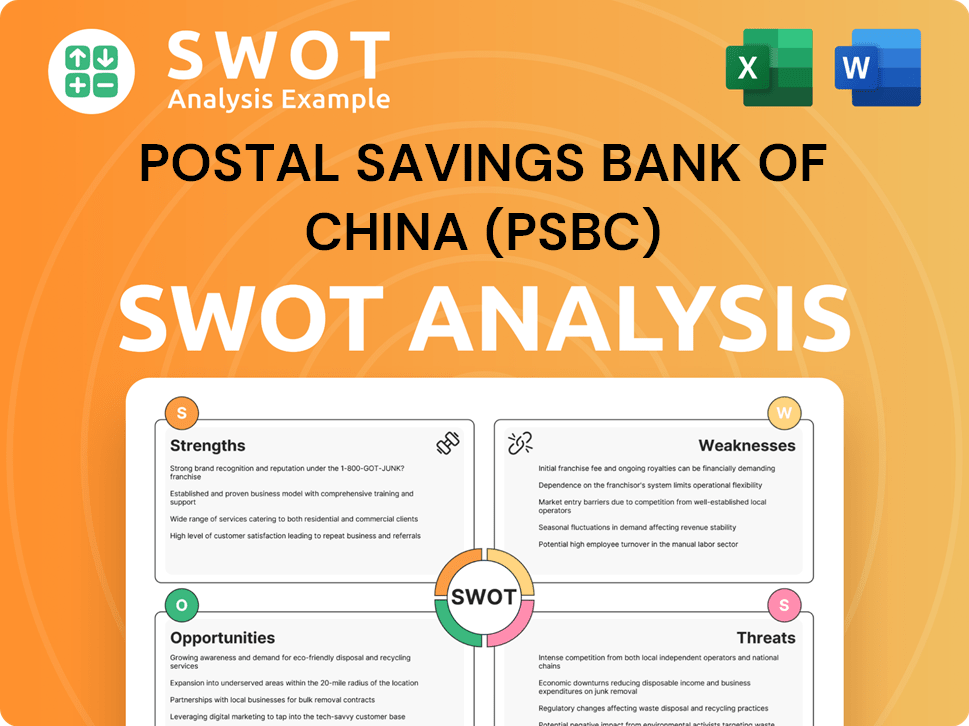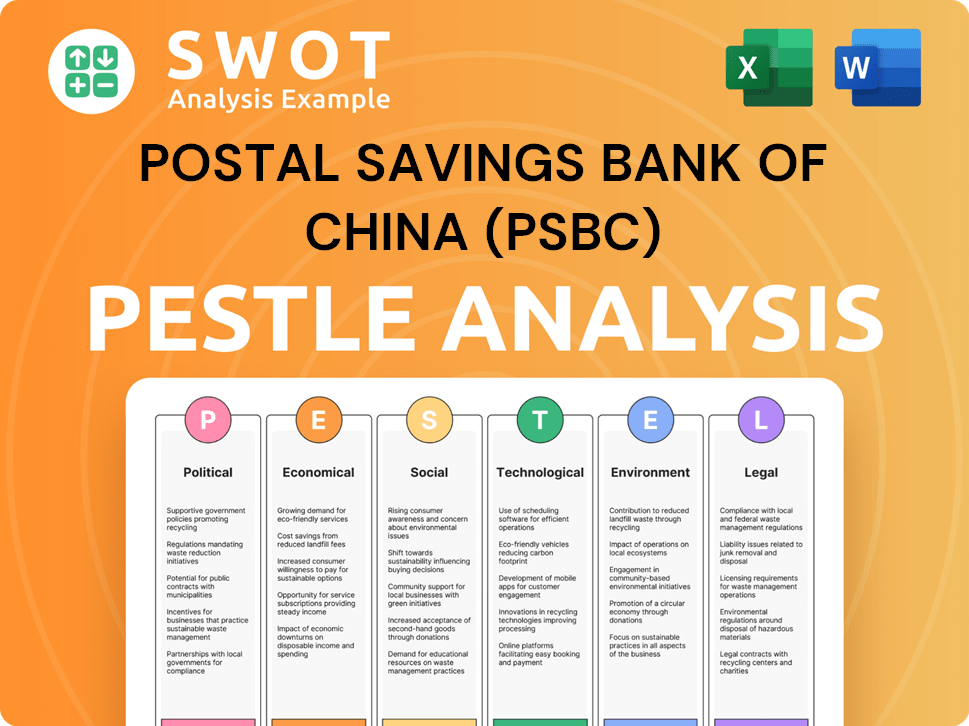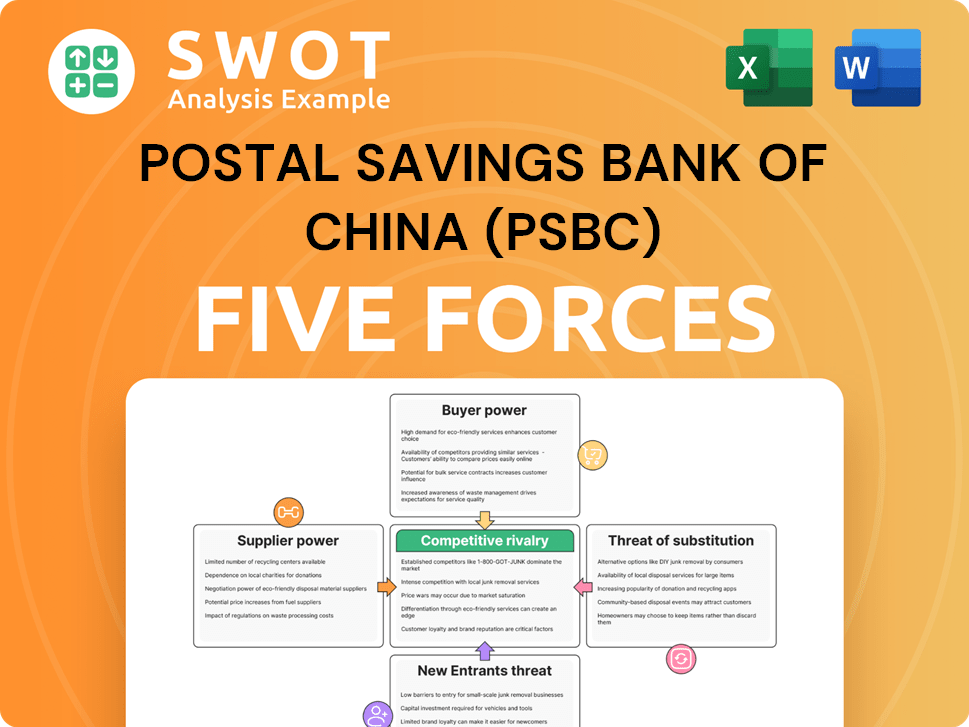Postal Savings Bank Of China (PSBC) Bundle
Who Really Owns Postal Savings Bank of China?
Unraveling the Postal Savings Bank Of China (PSBC) SWOT Analysis reveals more than just financial data; it unlocks the secrets behind one of China's largest financial institutions. Understanding the PSBC ownership structure is critical for investors, analysts, and anyone seeking to navigate the complexities of the Chinese financial market. Discovering who controls this massive China bank is key to understanding its strategic direction and future prospects.

From its inception, the PSBC owner profile has been a subject of keen interest, especially considering its unique origins within China Post Group. The evolution of PSBC ownership, from its state-backed beginnings to its current publicly traded status, offers valuable insights into the interplay between government influence and market dynamics. Examining the major shareholders and the bank ownership details provides a comprehensive understanding of its operational strategies and its role within Chinese financial institutions.
Who Founded Postal Savings Bank Of China (PSBC)?
The Postal Savings Bank of China (PSBC) was established in 2007. It emerged from the postal savings and remittance business of China Post Group. This transition marked the formal establishment of PSBC as a joint-stock limited company.
At its inception, China Post Group held 100% of the shares, making it the sole owner. This structure reflected a strategic move by the state-owned enterprise to expand its financial services. The initial focus was on leveraging the extensive postal network to enhance financial inclusion across China.
There weren't individual founders in the traditional sense. The creation of PSBC was a strategic initiative by China Post Group. The aim was to formalize and broaden financial services, especially in less developed regions.
China Post Group was the sole owner at the beginning.
No external investors or private individuals held stakes initially.
This was a restructuring of an existing state-owned financial operation.
The vision was to create a universal bank.
The bank would utilize its extensive reach, particularly in less developed areas.
The goal was to promote financial inclusion across China.
Complete control was held by China Post Group.
This structure supported national development goals.
It aimed to expand financial services to underserved communities.
Enhance financial inclusion.
Serve the vast population of China.
Support national development initiatives.
Leveraged the existing postal network.
Focused on expanding financial services.
Aimed to reach remote areas effectively.
Backed by China Post Group.
Provided a strong financial foundation.
Supported the bank's growth and expansion.
The initial PSBC ownership structure, with China Post Group as the sole shareholder, was designed to ensure the bank could effectively implement its mission. This included supporting national development and expanding financial services, especially in areas where access was limited. For insights into how PSBC has approached its market, see Marketing Strategy of Postal Savings Bank Of China (PSBC). This structure facilitated the bank's rapid growth and its ability to serve a broad customer base across China. As a China bank, PSBC's structure was a key factor in its early operational success and its ability to fulfill its strategic objectives. The Bank ownership by China Post Group provided a solid foundation for the bank's long-term development.
Postal Savings Bank Of China (PSBC) SWOT Analysis
- Complete SWOT Breakdown
- Fully Customizable
- Editable in Excel & Word
- Professional Formatting
- Investor-Ready Format

How Has Postal Savings Bank Of China (PSBC)’s Ownership Changed Over Time?
The evolution of PSBC ownership has been marked by key milestones, primarily the initial public offerings (IPOs) that transformed its shareholder base. In September 2016, the bank launched its H-share IPO on the Hong Kong Stock Exchange, raising approximately US$7.4 billion. This was the largest IPO globally that year. Later, in December 2019, PSBC completed its A-share IPO on the Shanghai Stock Exchange, further expanding its shareholder base within mainland China. These events significantly broadened the ownership structure, moving from a primarily state-controlled entity to one with a mix of institutional and public investors.
The PSBC owner structure is still largely state-controlled. The IPOs introduced market discipline and transparency, influencing governance and strategic decisions. The continuous strong state ownership ensures that the bank's strategy aligns with national economic policies. This blend of state control and public market participation shapes the bank's operations and strategic direction. For more insights, you can explore the Growth Strategy of Postal Savings Bank Of China (PSBC).
| Ownership Event | Date | Impact |
|---|---|---|
| H-share IPO | September 2016 | Raised approximately US$7.4 billion, diversified ownership. |
| A-share IPO | December 2019 | Expanded shareholder base within mainland China. |
| Ongoing Ownership | Late 2024/Early 2025 | Maintained state control with China Post Group as the largest shareholder. |
As of late 2024 and early 2025, China Post Group Co., Ltd. (formerly China Post Group Corporation) remains the dominant PSBC owner, holding a significant majority stake. As of December 31, 2023, the group held approximately 62.99% of the shares. Other major stakeholders include the National Council for Social Security Fund, which held around 6.5% of the bank's H-shares as of December 31, 2023. The presence of institutional investors, such as mutual funds and asset management companies, also contributes to the diverse ownership structure of this China bank. This blend of ownership ensures strategic alignment with national policies while incorporating market discipline.
The ownership of Postal Savings Bank of China is primarily state-controlled, with China Post Group as the major shareholder.
- The IPOs in 2016 and 2019 broadened the shareholder base.
- Institutional investors, including mutual funds, hold significant stakes.
- The structure balances state control with market influence.
- This structure impacts governance and strategic decisions.
Postal Savings Bank Of China (PSBC) PESTLE Analysis
- Covers All 6 PESTLE Categories
- No Research Needed – Save Hours of Work
- Built by Experts, Trusted by Consultants
- Instant Download, Ready to Use
- 100% Editable, Fully Customizable

Who Sits on Postal Savings Bank Of China (PSBC)’s Board?
The Board of Directors of Postal Savings Bank of China (PSBC) is pivotal in the bank's governance, reflecting its diverse ownership structure. As of early 2025, the board includes executive directors, non-executive directors, and independent non-executive directors. Many non-executive directors represent major shareholders, with China Post Group Co., Ltd. holding the largest stake. Individuals with backgrounds linked to China Post Group often hold key non-executive director positions, aligning with the dominant shareholder's strategic goals. Independent non-executive directors provide external oversight and ensure adherence to corporate governance best practices. This structure is crucial for understanding the competitive landscape of Postal Savings Bank of China.
The composition of the board and its decisions are influenced by the need to balance the interests of the controlling state entity with those of public and institutional investors. This balance is essential for maintaining stability and ensuring the bank’s long-term success. The voting structure of PSBC generally follows a one-share-one-vote principle for its ordinary shares, both A-shares and H-shares. However, due to China Post Group's substantial majority shareholding, it exercises significant control over major decisions, including the appointment of board members and strategic initiatives.
| Director Type | Description | Role |
|---|---|---|
| Executive Directors | Individuals involved in the day-to-day management of PSBC. | Oversee the bank's operations and implement strategic plans. |
| Non-Executive Directors | Represent major shareholders, particularly China Post Group. | Ensure alignment with the dominant shareholder's objectives and provide strategic guidance. |
| Independent Non-Executive Directors | Appointed to provide external oversight. | Ensure adherence to corporate governance best practices and represent the interests of minority shareholders. |
The voting structure at PSBC generally follows a one-share-one-vote principle for its ordinary shares. However, China Post Group's substantial shareholding grants it significant influence over major decisions. As of the latest available data, China Post Group Co., Ltd. holds a significant majority stake, influencing board appointments and strategic directions. While there are no publicly reported special voting rights, the significant shareholding of China Post Group ensures its influence. The board's decisions reflect the need to balance the interests of the controlling state entity with those of public and institutional investors, maintaining stability and long-term success.
The Board of Directors at Postal Savings Bank of China is structured to balance state control with public investor interests. This structure is key to understanding the bank's governance and strategic direction.
- China Post Group Co., Ltd. is the main shareholder, ensuring state influence.
- Non-executive directors often represent major shareholders.
- Independent directors provide external oversight.
- Voting follows a one-share-one-vote principle, with China Post Group holding significant influence.
Postal Savings Bank Of China (PSBC) Business Model Canvas
- Complete 9-Block Business Model Canvas
- Effortlessly Communicate Your Business Strategy
- Investor-Ready BMC Format
- 100% Editable and Customizable
- Clear and Structured Layout

What Recent Changes Have Shaped Postal Savings Bank Of China (PSBC)’s Ownership Landscape?
Over the last three to five years (2022-2025), the PSBC ownership structure has remained relatively stable. The main shareholder, China Post Group, continues to hold a significant stake, reflecting the bank's state-owned nature. The bank's focus has been on optimizing its financial structure through activities like issuing financial bonds to support business growth. This indicates active capital market engagement, though major shifts in core ownership percentages have not occurred.
The PSBC owner, China Post Group, maintains a dominant position, which aligns with the broader trend of state-backed financial institutions in China playing a key role in economic stability. PSBC has concentrated on organic growth and strategic partnerships rather than large-scale mergers. The influence of activist investors, common in Western markets, is less pronounced in major state-controlled Chinese banks. The bank's public statements often emphasize its commitment to serving the real economy, supporting rural revitalization, and promoting financial inclusion, all in line with its state-backed mandate. Future ownership changes are expected to be incremental, with the state maintaining its controlling stake to align with national strategic objectives. For further background, you can read a Brief History of Postal Savings Bank Of China (PSBC).
| Aspect | Details | Recent Trends (2022-2025) |
|---|---|---|
| Major Shareholder | China Post Group | Dominant and stable ownership; no significant changes. |
| Capital Management | Financial Bond Issuance | Ongoing to optimize liability structure and support growth. |
| Mergers and Acquisitions | Focus | Organic growth and strategic partnerships. |
The Chinese financial sector emphasizes the role of state-backed institutions like China bank in economic development. In the case of PSBC, the state's influence ensures alignment with national strategies. This is a key aspect of how Chinese financial institutions operate, with stability and strategic alignment being paramount.
The ownership structure of Postal Savings Bank of China has shown remarkable stability, with the state maintaining a controlling stake.
China Post Group remains the major shareholder, emphasizing the bank's state-owned status and strategic importance.
The bank concentrates on organic growth and strategic partnerships to expand its market presence.
Government influence ensures the bank's activities align with national economic objectives and financial inclusion goals.
Postal Savings Bank Of China (PSBC) Porter's Five Forces Analysis
- Covers All 5 Competitive Forces in Detail
- Structured for Consultants, Students, and Founders
- 100% Editable in Microsoft Word & Excel
- Instant Digital Download – Use Immediately
- Compatible with Mac & PC – Fully Unlocked

Related Blogs
- What are Mission Vision & Core Values of Postal Savings Bank Of China (PSBC) Company?
- What is Competitive Landscape of Postal Savings Bank Of China (PSBC) Company?
- What is Growth Strategy and Future Prospects of Postal Savings Bank Of China (PSBC) Company?
- How Does Postal Savings Bank Of China (PSBC) Company Work?
- What is Sales and Marketing Strategy of Postal Savings Bank Of China (PSBC) Company?
- What is Brief History of Postal Savings Bank Of China (PSBC) Company?
- What is Customer Demographics and Target Market of Postal Savings Bank Of China (PSBC) Company?
Disclaimer
All information, articles, and product details provided on this website are for general informational and educational purposes only. We do not claim any ownership over, nor do we intend to infringe upon, any trademarks, copyrights, logos, brand names, or other intellectual property mentioned or depicted on this site. Such intellectual property remains the property of its respective owners, and any references here are made solely for identification or informational purposes, without implying any affiliation, endorsement, or partnership.
We make no representations or warranties, express or implied, regarding the accuracy, completeness, or suitability of any content or products presented. Nothing on this website should be construed as legal, tax, investment, financial, medical, or other professional advice. In addition, no part of this site—including articles or product references—constitutes a solicitation, recommendation, endorsement, advertisement, or offer to buy or sell any securities, franchises, or other financial instruments, particularly in jurisdictions where such activity would be unlawful.
All content is of a general nature and may not address the specific circumstances of any individual or entity. It is not a substitute for professional advice or services. Any actions you take based on the information provided here are strictly at your own risk. You accept full responsibility for any decisions or outcomes arising from your use of this website and agree to release us from any liability in connection with your use of, or reliance upon, the content or products found herein.